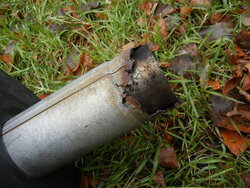I have a pc45 with Selkirk model VP venting, the VP is a PL rated pipe.
Venting is out the stove to a horizontal T (easy access), 12" to a 90, into the existing chimney, 90 up and out from basement, total rise about 24 feet. In the chimney is all Vp pipe not flex, it was actually a bit cheaper.
Question is, at what % of corn does the exhaust become corrosive enough to damage the pipe? I've read most people will run 50% corn without combustion issue's but has there been any observations of the pipe deterioration?
I'd assume Selkirk would say pellets only and any corn or other biofuels would require the DT-M series pipe.
This brings another question to mind, what is the life expectancy of a vent? And when it does fail where is the most likely spot?
yep, my mind wanders
Venting is out the stove to a horizontal T (easy access), 12" to a 90, into the existing chimney, 90 up and out from basement, total rise about 24 feet. In the chimney is all Vp pipe not flex, it was actually a bit cheaper.
Question is, at what % of corn does the exhaust become corrosive enough to damage the pipe? I've read most people will run 50% corn without combustion issue's but has there been any observations of the pipe deterioration?
I'd assume Selkirk would say pellets only and any corn or other biofuels would require the DT-M series pipe.
This brings another question to mind, what is the life expectancy of a vent? And when it does fail where is the most likely spot?
yep, my mind wanders


